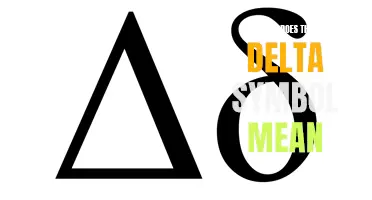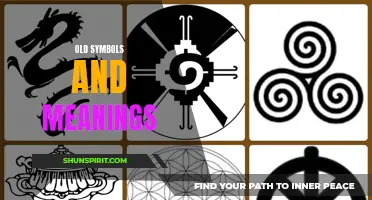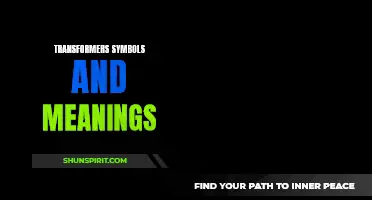
Henna has been used as a form of body art and decoration for centuries, with origins dating back to ancient Egypt and India. While henna designs come in countless intricate and beautiful patterns, they also hold deep meanings and symbolism. These meanings can vary depending on the culture and region, but they often reflect important values, beliefs, and rites of passage. From fertility and protection to love and spirituality, henna symbols hold a wealth of fascinating meaning that adds another layer of significance to this ancient and cherished art form.
What You'll Learn
- What are some examples of deep and meaningful henna symbols?
- How do henna symbols vary in meaning across different cultures?
- What is the significance of certain henna symbols in traditional ceremonies or rituals?
- Are there any universal henna symbols that hold deep meaning across cultures?
- How can individuals incorporate meaningful henna symbols into their own body art or designs?

What are some examples of deep and meaningful henna symbols?
Henna has been used for centuries as a form of body art and decoration. It is often associated with celebrations and special occasions, such as weddings and festivals. The intricate and beautiful patterns created with henna are not only aesthetically pleasing but also have deep and meaningful symbolism.
One of the most popular symbols used in henna designs is the lotus flower. The lotus is a highly significant symbol in many cultures. It represents purity, enlightenment, and rebirth. It is often associated with spiritual growth and the journey towards self-realization.
Another symbol commonly seen in henna designs is the peacock. In Hinduism, the peacock is considered a symbol of beauty, kindness, and good luck. It is believed to bring joy and prosperity to those who wear it. The vibrant colors and elegant feathers of the peacock make it a popular choice for henna designs.
The sun and moon are also frequently used symbols in henna art. The sun represents life, vitality, and energy. It symbolizes power and strength. The moon, on the other hand, represents femininity, intuition, and emotions. It is associated with the cycles of life and the ever-changing nature of the universe.
Mandalas are another common symbol used in henna designs. Mandalas are circular patterns that represent the universe and the interconnectedness of all things. They are often used for meditation and can be highly therapeutic. Mandalas in henna designs can symbolize harmony, balance, and unity.
Animals are also often depicted in henna designs, each with their own symbolism. For example, the elephant represents strength, wisdom, and good luck. The peacock symbolizes beauty and prosperity. The butterfly represents transformation and growth.
Symbols of love and fertility, such as hearts and flowers, are also commonly seen in henna designs. These symbols represent the beauty and power of love and the cycle of life.
Overall, henna symbols can have deep and meaningful significance. They can represent various aspects of life, spirituality, and personal beliefs. Each symbol carries its own unique meaning and can be chosen based on personal preference or the specific message one wishes to convey through their henna design. Whether it is the lotus flower, the peacock, or the sun and moon, henna symbols can add a touch of beauty and symbolism to any design.
The Intriguing Symbolism behind the Two Triangles Symbol
You may want to see also

How do henna symbols vary in meaning across different cultures?
Henna, also known as mehndi, is a traditional form of body art that has been practiced for centuries in various cultures around the world. The application of henna involves creating intricate designs on the skin using a paste made from the leaves of the henna plant. These designs, often in the form of symbols and patterns, hold different meanings across different cultures.
In Indian culture, henna is commonly used for festive occasions such as weddings and religious festivals. The designs typically feature intricate floral and paisley patterns, as well as symbols representing love, fertility, and prosperity. The bride's hands and feet are often adorned with elaborate henna designs, which are believed to bring good luck and protect against evil spirits. Henna is also used to celebrate various milestones and achievements in Indian culture.
In Middle Eastern culture, henna is often associated with celebrations such as Eid and weddings. The designs typically feature geometric patterns and motifs such as peacocks and crescent moons. Henna is believed to bring blessings and ward off the evil eye. In some Middle Eastern cultures, henna is also used to mark special occasions such as childbirth and coming of age ceremonies.
In North African culture, henna is an integral part of traditional weddings. The designs often consist of geometric patterns and symbols representing fertility, protection, and blessings. The bride's hands and feet are adorned with henna as a symbol of beauty and good luck. In some North African cultures, henna is also used to mark important life events such as childbirth and religious celebrations.
In Southeast Asian culture, henna is commonly used for celebrations such as weddings and festivals. The designs often feature intricate floral patterns, as well as symbols representing love, happiness, and protection. Henna is considered a symbol of beauty and femininity in Southeast Asian culture, and the application of henna is often seen as a form of self-expression and creativity.
Overall, while henna symbols may vary in meaning across different cultures, they all share a common thread of celebration, beauty, and protection. Whether used for weddings, festivals, or other special occasions, henna is a cherished form of art that continues to be passed down through generations. Its intricate designs and meaningful symbols serve as a reflection of the rich cultural heritage and traditions of the diverse communities that practice this ancient art form.
Exploring the Symbolic Depths: Unraveling the Meaning of the Tree of Life Symbol
You may want to see also

What is the significance of certain henna symbols in traditional ceremonies or rituals?
Henna, a natural dye made from the leaves of the henna plant, has been used for centuries in various cultures as a form of body art. In many traditional ceremonies or rituals, henna is applied to the hands and feet of individuals as a way to celebrate or commemorate special occasions. These intricate henna designs often feature symbolic patterns and symbols that hold significant meanings in the context of the specific event.
One of the most common symbols used in henna designs is the lotus flower. In many cultures, the lotus flower is seen as a symbol of purity, beauty, and spiritual awakening. It represents the journey of the soul, as the lotus flower grows from the muddy water to bloom above the surface, untouched by the impurities below. In traditional ceremonies, the lotus flower symbolizes the purity and divinity of the individual or the union being celebrated.
Another meaningful symbol often incorporated into henna designs is the peacock feather. The peacock is known for its vibrant and eye-catching plumage, which symbolizes beauty, grace, and protection. In many cultures, the peacock feather is believed to bring good luck and ward off evil spirits. It is often used in henna designs to bless the individual or couple with a prosperous and harmonious future.
In certain ceremonies, the hamsa hand symbol can be seen in henna designs. The hamsa hand, also known as the Hand of Fatima or Hand of Miriam, is a symbol of protection in many Middle Eastern and North African cultures. It is believed to bring good fortune, happiness, and health to the person wearing it. The hamsa hand in henna designs is a way to ward off evil and ensure the safety and well-being of the individual or couple.
Other common henna symbols include the sun, moon, stars, and flowers. The sun represents vitality, energy, and life, while the moon and stars symbolize the divine and spiritual guidance. Flowers, on the other hand, can have various meanings depending on the specific type. For example, roses symbolize love and passion, while lotus represents purity and enlightenment.
In conclusion, henna symbols hold great significance in traditional ceremonies or rituals. They are not just decorative elements but carry deep meanings that reflect the beliefs, values, and aspirations of the culture. From the lotus flower symbolizing purity to the peacock feather representing protection and the hamsa hand warding off evil, henna designs tell a story and add a meaningful touch to the special occasions they are a part of.
Decoding the Illuminati Symbol: Unveiling its Hidden Meaning
You may want to see also

Are there any universal henna symbols that hold deep meaning across cultures?
Henna, also known as mehndi, is a form of body art that has been practiced for centuries across various cultures. The application of henna involves creating intricate designs on the skin using a paste made from the henna plant. These designs can have deep symbolic meaning and are often associated with celebrations, weddings, and other special occasions.
While henna designs can vary greatly from culture to culture, there are certain symbols that hold universal meaning and are often used in henna art across different traditions. These symbols have deep cultural significance and can convey messages of love, protection, and fertility.
One such universal symbol used in henna art is the lotus flower. The lotus is a sacred symbol in many Eastern religions and represents purity, enlightenment, and rebirth. It is often depicted as a fully bloomed flower, with its petals open to the world. The lotus is believed to represent the journey of the soul, rising from the mud and darkness to achieve spiritual enlightenment.
Another symbol commonly used in henna art is the peacock. The peacock is a majestic bird known for its vibrant colors and extravagant display of feathers. In many cultures, the peacock is associated with beauty, grace, and good luck. It is often used to symbolize prosperity and abundance.
The tree of life is another universal symbol that holds deep meaning in henna art. The tree of life represents the interconnectedness of all living things and symbolizes growth, strength, and wisdom. It is often depicted with roots that reach deep into the ground and branches that extend high into the sky, representing the connection between the physical and spiritual worlds.
A symbol that is often used in henna art across cultures is the mandala. Mandalas are intricate geometric designs that represent the universe and the infinite nature of existence. They are often used as a tool for meditation and spiritual reflection. Mandalas can be found in many different cultures, from Hinduism to Buddhism to Native American traditions, and are believed to promote balance and harmony.
Other symbols commonly used in henna art include the sun, moon, stars, and various geometric patterns. These symbols can carry different meanings depending on the culture and context in which they are used.
It is important to note that while certain symbols may hold universal meaning, the specific designs and patterns used in henna art can vary greatly between cultures and individuals. Henna art is a deeply personal form of expression, and each design is created with care and intention.
In conclusion, while there are universal symbols used in henna art that hold deep meaning across cultures, the specific designs and patterns can vary greatly. Symbols such as the lotus flower, peacock, tree of life, and mandala are often used to convey messages of love, protection, and spiritual growth. However, it is important to respect and appreciate the cultural context in which these symbols are used and to understand that henna art is a unique and personal form of expression for each individual.
Understanding the Meaning and Symbolism of the Pedi Symbol
You may want to see also

How can individuals incorporate meaningful henna symbols into their own body art or designs?
Henna has been used for centuries to create beautiful designs on the body. Its intricate patterns and deep symbolism make it a popular choice for body art and temporary tattoos. In recent years, there has been a growing interest in incorporating meaningful henna symbols into body art. Individuals are increasingly looking to use henna not just for its aesthetic appeal, but also as a way to express their values, beliefs, and personal experiences.
One way individuals can incorporate meaningful henna symbols into their own body art or designs is by choosing symbols that hold significance to them personally. For example, someone might choose to incorporate the hamsa hand symbol, which is believed to offer protection from evil and bring good fortune. This symbol has deep roots in many cultures and is often seen as a symbol of power and strength. By incorporating this symbol into their henna design, individuals can not only create a visually appealing design but also express their desire for protection and good luck.
Another way to incorporate meaningful henna symbols is by using symbols associated with specific emotions or experiences. For example, someone who has recently overcome a difficult period in their life might choose to incorporate the lotus flower symbol, which represents growth, resilience, and the ability to rise above challenges. By incorporating this symbol into their henna design, individuals can celebrate their personal growth and remind themselves of their strength and resilience.
Furthermore, individuals can also incorporate henna symbols that represent their cultural heritage. Henna has a rich history and is deeply rooted in many cultures around the world. By incorporating symbols from their cultural background, individuals can not only pay homage to their heritage but also express their identity and connection to their roots. For example, someone with Indian heritage might choose to incorporate traditional Indian motifs such as peacocks, mangoes, or paisley designs into their henna design. These symbols not only add beauty but also hold deep cultural significance.
When it comes to incorporating meaningful henna symbols, it is important to remember that the ultimate goal is for the symbol to hold personal significance to the individual. By choosing symbols that hold meaning and relevance to their own lives, individuals can create henna designs that not only look visually appealing but also serve as powerful reminders of their values, beliefs, and personal experiences.
In conclusion, incorporating meaningful henna symbols into body art or designs is a way for individuals to not only create visually appealing designs but also express their beliefs, values, and personal experiences. By choosing symbols that hold personal significance, individuals can infuse their henna designs with deep meaning and create powerful reminders of their identity and personal growth. Whether it is through symbols that hold cultural significance, symbols associated with specific emotions or experiences, or symbols that represent personal values, incorporating meaningful henna symbols allows individuals to truly make their body art their own.
The Profound Symbolic Meaning Behind the Lotus Flower
You may want to see also
Frequently asked questions
The lotus flower is a highly meaningful symbol in henna designs. It represents purity, enlightenment, and the journey of spiritual growth. The lotus flower is often associated with the concept of rising above adversity and achieving a state of peace and tranquility.
The peacock feather is a popular symbol in henna art and holds deep meaning. It represents beauty, grace, and abundance. The intricate design of the peacock feather also symbolizes creativity and artistic expression. It is often included in henna designs to bring good luck and positive energy.
The elephant symbol is highly revered in many cultures and holds various meanings in henna patterns. It is often associated with strength, wisdom, and prosperity. The elephant is also seen as a symbol of good luck and is believed to bring positive energies into one's life.
The tree of life is a powerful and deeply meaningful symbol in henna tattoos. It represents the interconnectedness of all living beings and the cyclical nature of life. The branches reaching upwards symbolize growth, while the roots represent stability and grounding. This symbol is often used to express a connection to nature, the importance of family and ancestry, and the balance between life and death.







